child restraint FIAT 500L 2015 2.G User Guide
[x] Cancel search | Manufacturer: FIAT, Model Year: 2015, Model line: 500L, Model: FIAT 500L 2015 2.GPages: 148, PDF Size: 3.77 MB
Page 3 of 148
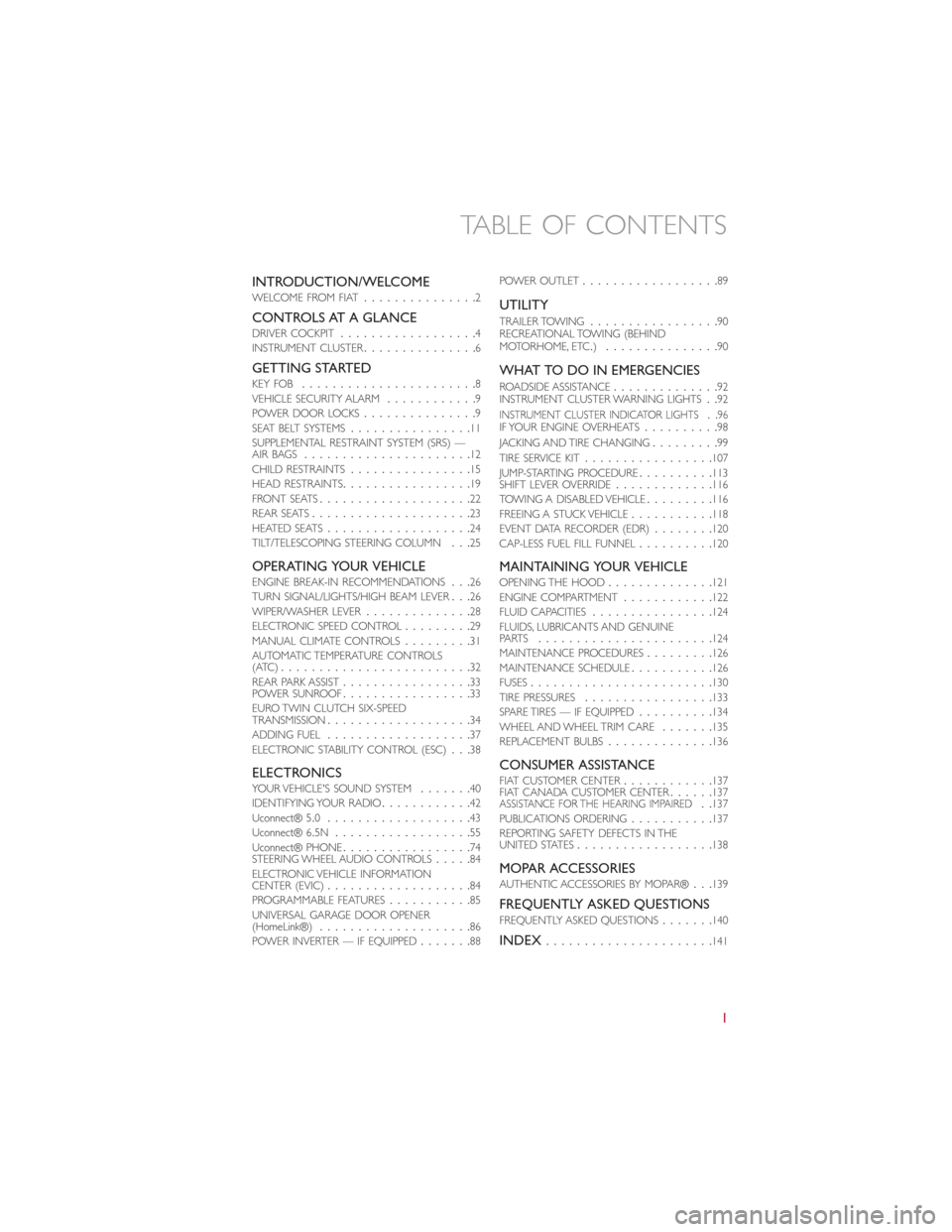
INTRODUCTION/WELCOMEWELCOME FROM FIAT...............2
CONTROLS AT A GLANCEDRIVER COCKPIT..................4INSTRUMENT CLUSTER...............6
GETTING STARTEDKEY FOB.......................8VEHICLE SECURITY ALARM............9POWER DOOR LOCKS...............9SEAT BELT SYSTEMS................11SUPPLEMENTAL RESTRAINT SYSTEM (SRS) —AIR BAGS......................12CHILD RESTRAINTS................15HEAD RESTRAINTS.................19FRONT SEATS....................22REAR SEATS.....................23HEATED SEATS...................24TILT/TELESCOPING STEERING COLUMN...25
OPERATING YOUR VEHICLEENGINE BREAK-IN RECOMMENDATIONS...26TURN SIGNAL/LIGHTS/HIGH BEAM LEVER...26WIPER/WASHER LEVER..............28ELECTRONIC SPEED CONTROL.........29MANUAL CLIMATE CONTROLS.........31AUTOMATIC TEMPERATURE CONTROLS(ATC).........................32REAR PARK ASSIST.................33POWER SUNROOF.................33EURO TWIN CLUTCH SIX-SPEEDTRANSMISSION...................34ADDING FUEL...................37ELECTRONIC STABILITY CONTROL (ESC)...38
ELECTRONICSYO U R V E H I C L E ' S S O U N D S YS T E M.......40IDENTIFYING YOUR RADIO............42Uconnect® 5.0...................43Uconnect® 6.5N..................55Uconnect® PHONE.................74STEERING WHEEL AUDIO CONTROLS.....84ELECTRONIC VEHICLE INFORMATIONCENTER (EVIC)...................84PROGRAMMABLE FEATURES...........85UNIVERSAL GARAGE DOOR OPENER(HomeLink®)....................86POWER INVERTER — IF EQUIPPED.......88
POWER OUTLET..................89
UTILITY
TRAILER TOWING.................90RECREATIONAL TOWING (BEHINDMOTORHOME, ETC.)...............90
WHAT TO DO IN EMERGENCIES
ROADSIDE ASSISTANCE..............92INSTRUMENT CLUSTER WARNING LIGHTS..92INSTRUMENT CLUSTER INDICATOR LIGHTS..96IF YOUR ENGINE OVERHEATS..........98JACKING AND TIRE CHANGING.........99TIRE SERVICE KIT.................107JUMP-STARTING PROCEDURE..........113SHIFT LEVER OVERRIDE.............116TOW I N G A D I S A B L E D V E H I C L E.........116FREEING A STUCK VEHICLE...........118EVENT DATA RECORDER (EDR)........120CAP-LESS FUEL FILL FUNNEL..........120
MAINTAINING YOUR VEHICLEOPENING THE HOOD..............121ENGINE COMPARTMENT............122FLUID CAPACITIES................124FLUIDS, LUBRICANTS AND GENUINEPA RT S.......................124MAINTENANCE PROCEDURES.........126MAINTENANCE SCHEDULE...........126FUSES........................130TIRE PRESSURES.................133SPARE TIRES — IF EQUIPPED..........134WHEEL AND WHEEL TRIM CARE.......135REPLACEMENT BULBS..............136
CONSUMER ASSISTANCEFIAT CUSTOMER CENTER............137FIAT CANADA CUSTOMER CENTER......137ASSISTANCE FOR THE HEARING IMPAIRED..137PUBLICATIONS ORDERING...........137REPORTING SAFETY DEFECTS IN THEUNITED STATES..................138
MOPAR ACCESSORIESAUTHENTIC ACCESSORIES BY MOPAR®...139
FREQUENTLY ASKED QUESTIONSFREQUENTLY ASKED QUESTIONS.......140
INDEX......................141
TABLE OF CONTENTS
1
Page 17 of 148
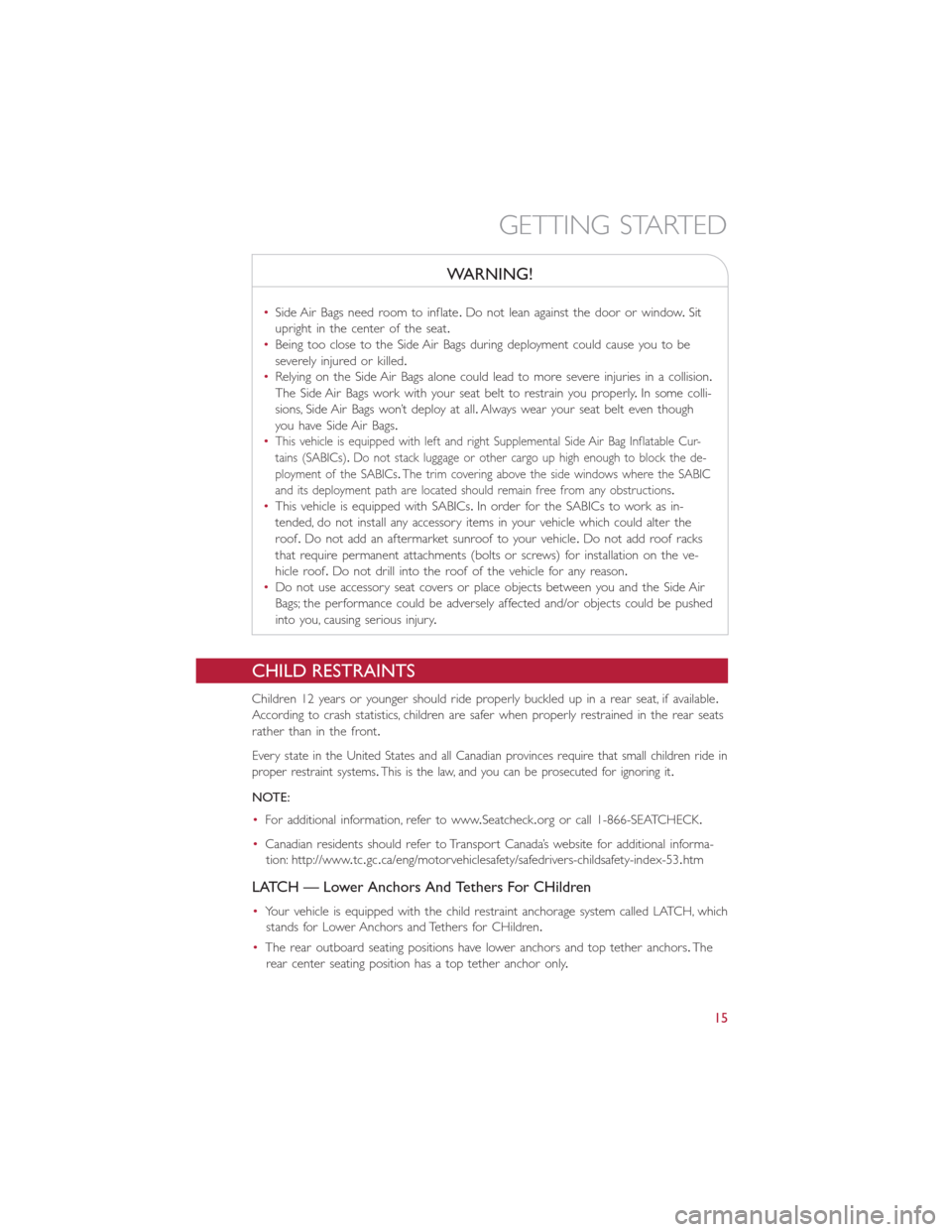
WARNING!
•Side Air Bags need room to inflate.Do not lean against the door or window.Sit
upright in the center of the seat.
•Being too close to the Side Air Bags during deployment could cause you to be
severely injured or killed.
•Relying on the Side Air Bags alone could lead to more severe injuries in a collision.
The Side Air Bags work with your seat belt to restrain you properly.In some colli-
sions, Side Air Bags won’t deploy at all.Always wear your seat belt even though
you have Side Air Bags.
•This vehicle is equipped with left and right Supplemental Side Air Bag Inflatable Cur-
tains (SABICs).Do not stack luggage or other cargo up high enough to block the de-
ployment of the SABICs.The trim covering above the side windows where the SABIC
and its deployment path are located should remain free from any obstructions.
•This vehicle is equipped with SABICs.In order for the SABICs to work as in-
tended, do not install any accessory items in your vehicle which could alter the
roof.Do not add an aftermarket sunroof to your vehicle.Do not add roof racks
that require permanent attachments (bolts or screws) for installation on the ve-
hicle roof.Do not drill into the roof of the vehicle for any reason.
•Do not use accessory seat covers or place objects between you and the Side Air
Bags; the performance could be adversely affected and/or objects could be pushed
into you, causing serious injury.
CHILD RESTRAINTS
Children 12 years or younger should ride properly buckled up in a rear seat, if available.
According to crash statistics, children are safer when properly restrained in the rear seats
rather than in the front.
Every state in the United States and all Canadian provinces require that small children ride in
proper restraint systems.This is the law, and you can be prosecuted for ignoring it.
NOTE:
•For additional information, refer to www.Seatcheck.org or call 1-866-SEATCHECK.
•Canadian residents should refer to Transport Canada’s website for additional informa-
tion: http://www.tc.gc.ca/eng/motorvehiclesafety/safedrivers-childsafety-index-53.htm
LATCH — Lower Anchors And Tethers For CHildren
•Your vehicle is equipped with the child restraint anchorage system called LATCH, which
stands for Lower Anchors and Tethers for CHildren.
•The rear outboard seating positions have lower anchors and top tether anchors.The
rear center seating position has a top tether anchor only.
GETTING STARTED
15
Page 18 of 148
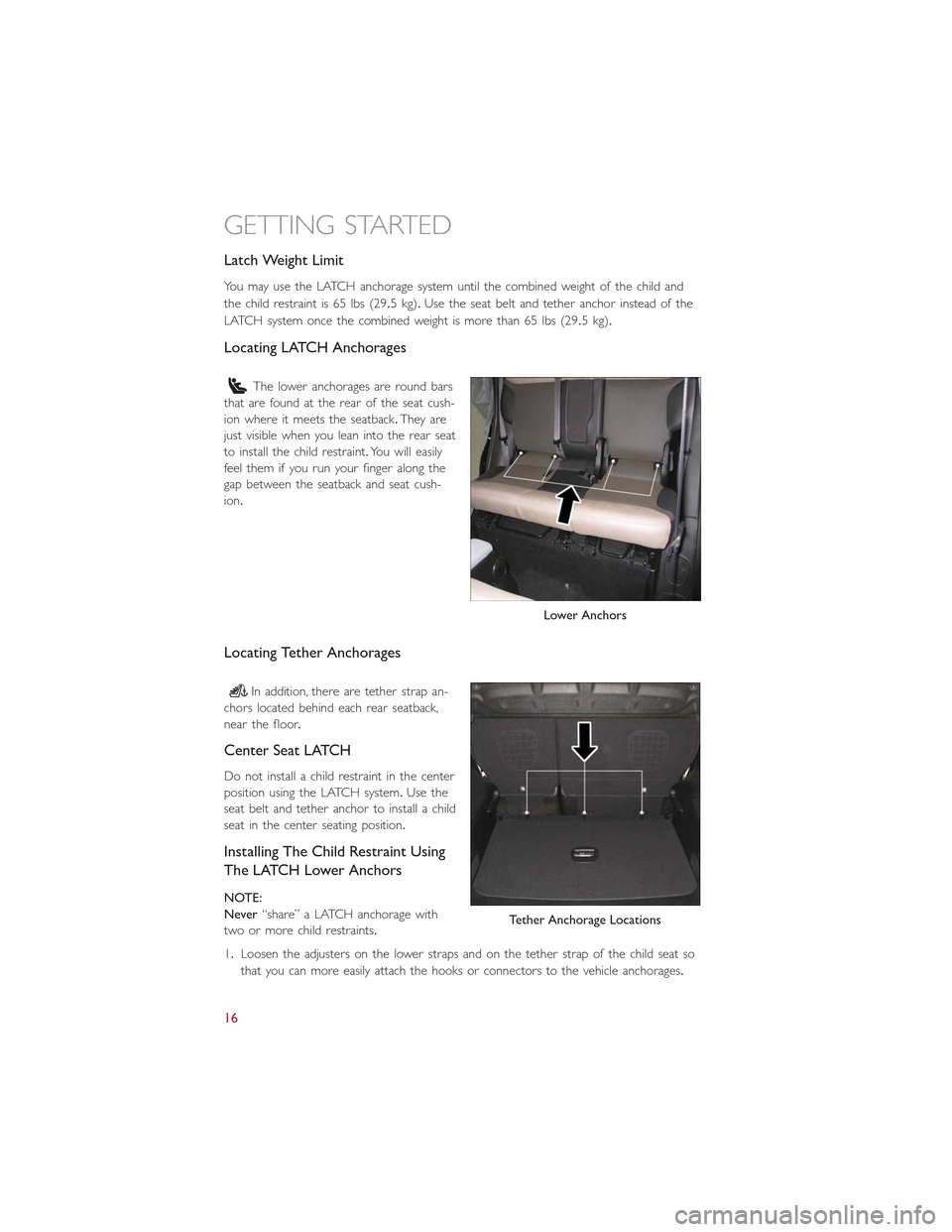
Latch Weight Limit
You may use the LATCH anchorage system until the combined weight of the child and
the child restraint is 65 lbs (29.5 kg).Use the seat belt and tether anchor instead of the
LATCH system once the combined weight is more than 65 lbs (29.5 kg).
Locating LATCH Anchorages
The lower anchorages are round bars
that are found at the rear of the seat cush-
ion where it meets the seatback.They are
just visible when you lean into the rear seat
to install the child restraint.You will easily
feel them if you run your finger along the
gap between the seatback and seat cush-
ion.
Locating Tether Anchorages
In addition, there are tether strap an-
chors located behind each rear seatback,
near the floor.
Center Seat LATCH
Do not install a child restraint in the center
position using the LATCH system.Use the
seat belt and tether anchor to install a child
seat in the center seating position.
Installing The Child Restraint Using
The LATCH Lower Anchors
NOTE:
Never“share” a LATCH anchorage with
two or more child restraints.
1.Loosen the adjusters on the lower straps and on the tether strap of the child seat so
that you can more easily attach the hooks or connectors to the vehicle anchorages.
Lower Anchors
Tether Anchorage Locations
GETTING STARTED
16
Page 19 of 148
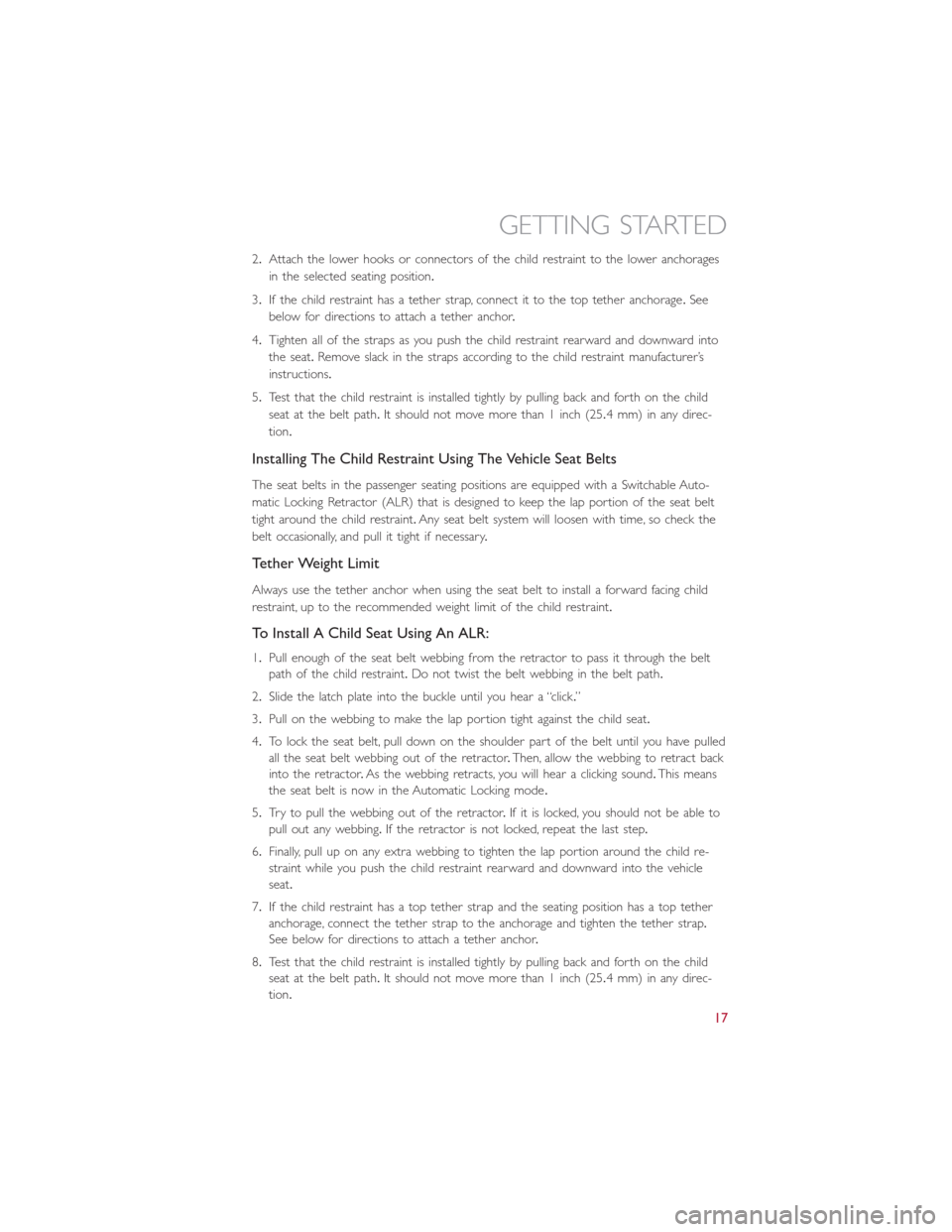
2.Attach the lower hooks or connectors of the child restraint to the lower anchorages
in the selected seating position.
3.If the child restraint has a tether strap, connect it to the top tether anchorage.See
below for directions to attach a tether anchor.
4.Tighten all of the straps as you push the child restraint rearward and downward into
the seat.Remove slack in the straps according to the child restraint manufacturer’s
instructions.
5.Test that the child restraint is installed tightly by pulling back and forth on the child
seat at the belt path.It should not move more than 1 inch (25.4 mm) in any direc-
tion.
Installing The Child Restraint Using The Vehicle Seat Belts
The seat belts in the passenger seating positions are equipped with a Switchable Auto-
matic Locking Retractor (ALR) that is designed to keep the lap portion of the seat belt
tight around the child restraint.Any seat belt system will loosen with time, so check the
belt occasionally, and pull it tight if necessary.
Tether Weight Limit
Always use the tether anchor when using the seat belt to install a forward facing child
restraint, up to the recommended weight limit of the child restraint.
To Install A Child Seat Using An ALR:
1.Pull enough of the seat belt webbing from the retractor to pass it through the belt
path of the child restraint.Do not twist the belt webbing in the belt path.
2.Slide the latch plate into the buckle until you hear a “click.”
3.Pull on the webbing to make the lap portion tight against the child seat.
4.To lock the seat belt, pull down on the shoulder part of the belt until you have pulled
all the seat belt webbing out of the retractor.Then, allow the webbing to retract back
into the retractor.As the webbing retracts, you will hear a clicking sound.This means
the seat belt is now in the Automatic Locking mode.
5.Try to pull the webbing out of the retractor.If it is locked, you should not be able to
pull out any webbing.If the retractor is not locked, repeat the last step.
6.Finally, pull up on any extra webbing to tighten the lap portion around the child re-
straint while you push the child restraint rearward and downward into the vehicle
seat.
7.If the child restraint has a top tether strap and the seating position has a top tether
anchorage, connect the tether strap to the anchorage and tighten the tether strap.
See below for directions to attach a tether anchor.
8.Test that the child restraint is installed tightly by pulling back and forth on the child
seat at the belt path.It should not move more than 1 inch (25.4 mm) in any direc-
tion.
GETTING STARTED
17
Page 20 of 148

Installing The Top Tether Strap (With Either Lower Anchors Or Vehicle
Seat Belt):
When installing a forward-facing child restraint, always secure the top tether strap, up to
the tether anchor weight limit, whether the child restraint is installed with the lower an-
chors or the vehicle seat belt.
Tether Anchorage Installation
1.Route the tether strap to provide the most direct path for the strap between the
anchor and the child seat.
2.If your vehicle is equipped with adjust-
able rear head restraints, raise the head
restraint, and where possible, route the
tether strap under the head restraint
and between the two posts.If not pos-
sible, lower the head restraint and pass
the tether strap around the outboard
side of the head restraint.
3.Attach the tether strap hook of the
child restraint to the top tether anchor-
age and remove slack in the tether strap according to the child restraint manufactur-
er’s instructions.
WARNING!
Securely lock the seat cushion into position before using the seat.Otherwise, the seat
will not provide the proper stability for child seats and/or passengers.An improperly
latched seat cushion could cause serious injury.
Rear Seat Tether Strap Mounting
GETTING STARTED
18
Page 21 of 148
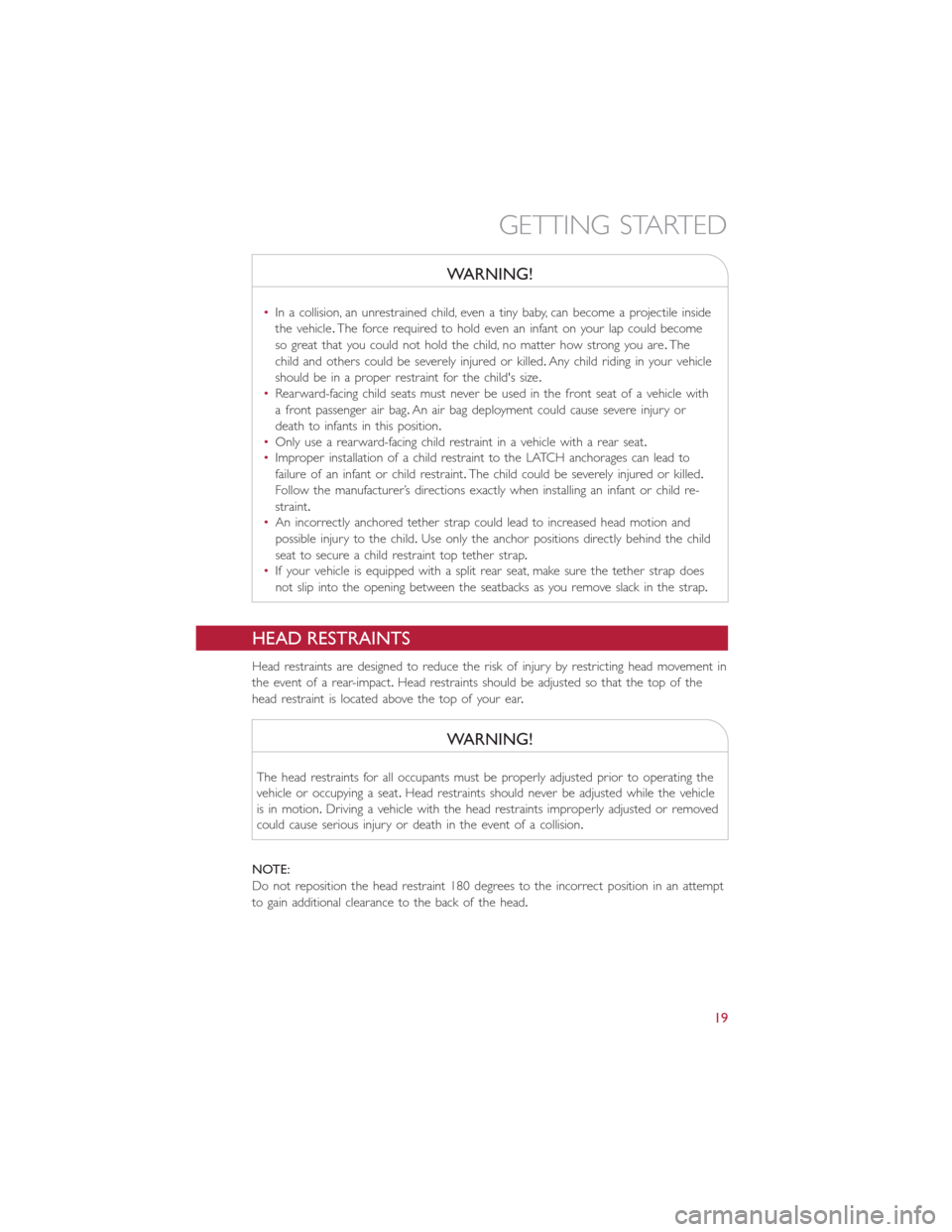
WARNING!
•In a collision, an unrestrained child, even a tiny baby, can become a projectile inside
the vehicle.The force required to hold even an infant on your lap could become
so great that you could not hold the child, no matter how strong you are.The
child and others could be severely injured or killed.Any child riding in your vehicle
should be in a proper restraint for the child's size.
•Rearward-facing child seats must never be used in the front seat of a vehicle with
a front passenger air bag.An air bag deployment could cause severe injury or
death to infants in this position.
•Only use a rearward-facing child restraint in a vehicle with a rear seat.
•Improper installation of a child restraint to the LATCH anchorages can lead to
failure of an infant or child restraint.The child could be severely injured or killed.
Follow the manufacturer’s directions exactly when installing an infant or child re-
straint.
•An incorrectly anchored tether strap could lead to increased head motion and
possible injury to the child.Use only the anchor positions directly behind the child
seat to secure a child restraint top tether strap.
•If your vehicle is equipped with a split rear seat, make sure the tether strap does
not slip into the opening between the seatbacks as you remove slack in the strap.
HEAD RESTRAINTS
Head restraints are designed to reduce the risk of injury by restricting head movement in
the event of a rear-impact.Head restraints should be adjusted so that the top of the
head restraint is located above the top of your ear.
WARNING!
The head restraints for all occupants must be properly adjusted prior to operating the
vehicle or occupying a seat.Head restraints should never be adjusted while the vehicle
is in motion.Driving a vehicle with the head restraints improperly adjusted or removed
could cause serious injury or death in the event of a collision.
NOTE:
Do not reposition the head restraint 180 degrees to the incorrect position in an attempt
to gain additional clearance to the back of the head.
GETTING STARTED
19
Page 23 of 148
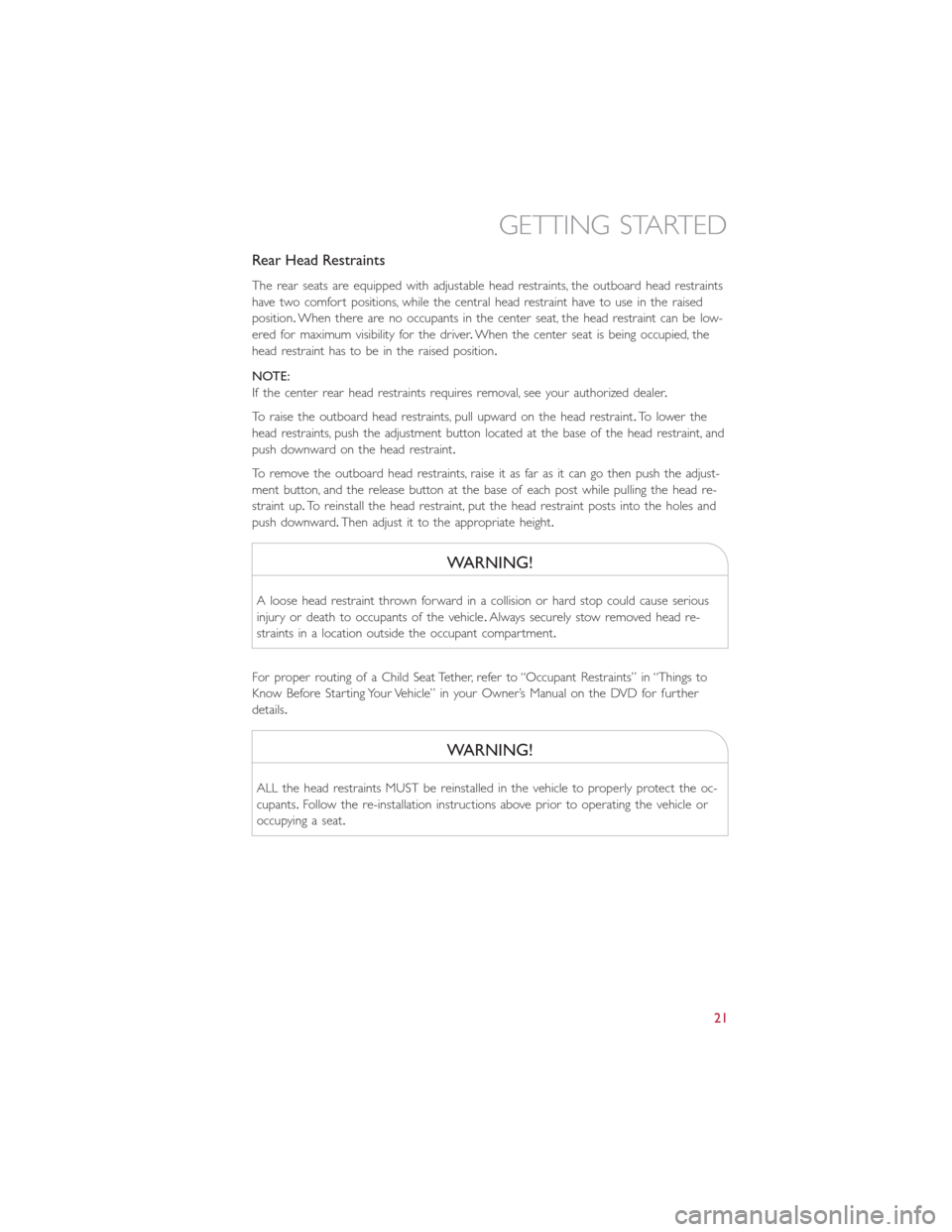
Rear Head Restraints
The rear seats are equipped with adjustable head restraints, the outboard head restraints
have two comfort positions, while the central head restraint have to use in the raised
position.When there are no occupants in the center seat, the head restraint can be low-
ered for maximum visibility for the driver.When the center seat is being occupied, the
head restraint has to be in the raised position.
NOTE:
If the center rear head restraints requires removal, see your authorized dealer.
To raise the outboard head restraints, pull upward on the head restraint.To lower the
head restraints, push the adjustment button located at the base of the head restraint, and
push downward on the head restraint.
To remove the outboard head restraints, raise it as far as it can go then push the adjust-
ment button, and the release button at the base of each post while pulling the head re-
straint up.To reinstall the head restraint, put the head restraint posts into the holes and
push downward.Then adjust it to the appropriate height.
WARNING!
A loose head restraint thrown forward in a collision or hard stop could cause serious
injury or death to occupants of the vehicle.Always securely stow removed head re-
straints in a location outside the occupant compartment.
For proper routing of a Child Seat Tether, refer to “Occupant Restraints” in “Things to
Know Before Starting Your Vehicle” in your Owner’s Manual on the DVD for further
details.
WARNING!
ALL the head restraints MUST be reinstalled in the vehicle to properly protect the oc-
cupants.Follow the re-installation instructions above prior to operating the vehicle or
occupying a seat.
GETTING STARTED
21
Page 143 of 148
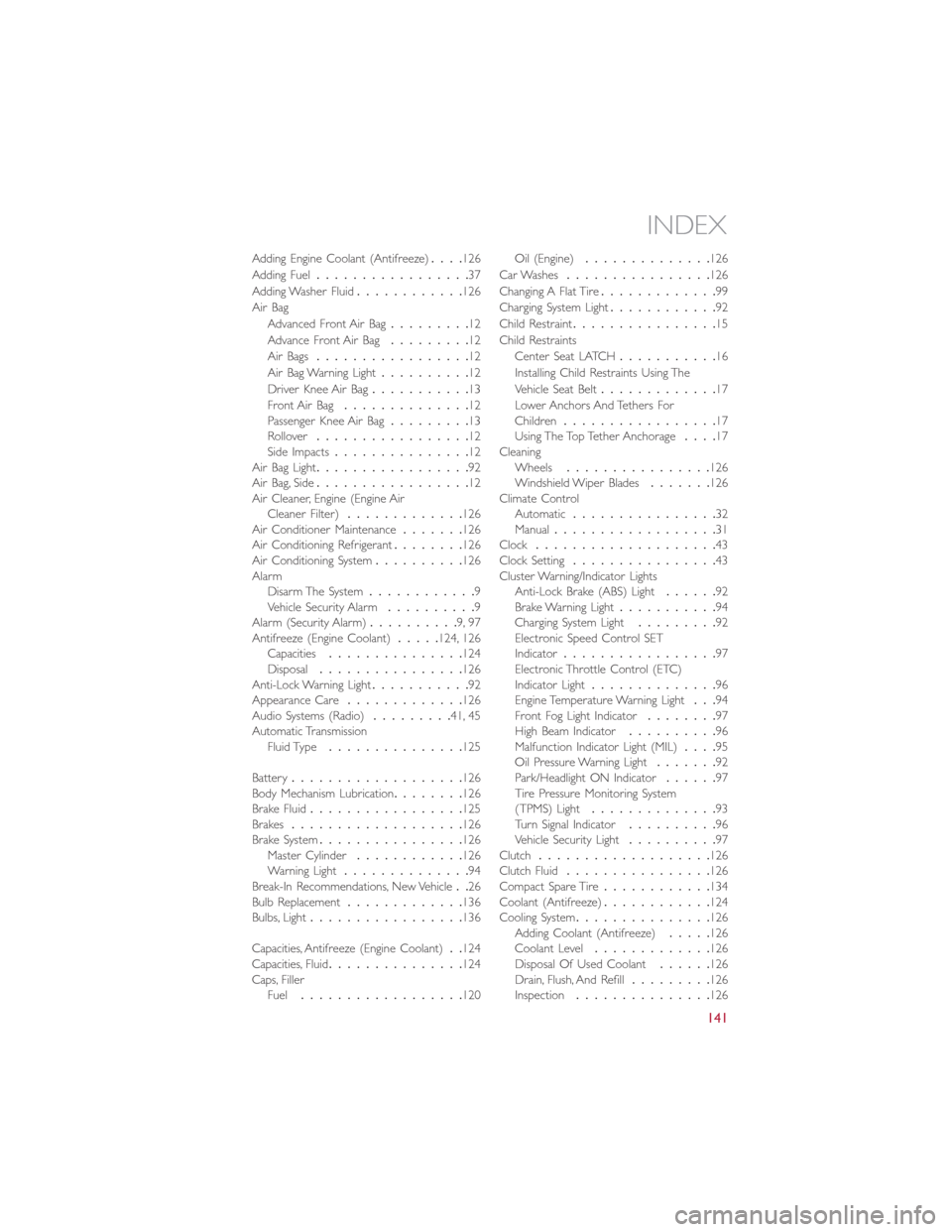
Adding Engine Coolant (Antifreeze)....126
Adding Fuel.................37
Adding Washer Fluid............126
Air Bag
Advanced Front Air Bag.........12
Advance Front Air Bag.........12
Air Bags.................12
Air Bag Warning Light..........12
Driver Knee Air Bag...........13
Front Air Bag..............12Passenger Knee Air Bag.........13Rollover.................12Side Impacts...............12Air Bag Light.................92Air Bag, Side.................12Air Cleaner, Engine (Engine AirCleaner Filter).............126Air Conditioner Maintenance.......126Air Conditioning Refrigerant........126Air Conditioning System..........126AlarmDisarm The System............9Vehicle Security Alarm..........9Alarm (Security Alarm)..........9, 97Antifreeze (Engine Coolant).....124, 126Capacities...............124Disposal................126Anti-Lock Warning Light...........92Appearance Care.............126Audio Systems (Radio).........41, 45Automatic TransmissionFluid Type...............125
Battery...................126Body Mechanism Lubrication........126Brake Fluid.................125Brakes...................126Brake System................126Master Cylinder............126Warning Light..............94Break-In Recommendations, New Vehicle..26Bulb Replacement.............136Bulbs, Light.................136
Capacities, Antifreeze (Engine Coolant)..124Capacities, Fluid...............124Caps, FillerFuel..................120
Oil (Engine)..............126
Car Washes................126
Changing A Flat Tire.............99
Charging System Light............92
Child Restraint................15
Child Restraints
Center Seat LATCH...........16
Installing Child Restraints Using The
Vehicle Seat Belt.............17
Lower Anchors And Tethers ForChildren.................17Using The Top Tether Anchorage....17CleaningWheels................126Windshield Wiper Blades.......126Climate ControlAutomatic................32Manual..................31Clock....................43Clock Setting................43Cluster Warning/Indicator LightsAnti-Lock Brake (ABS) Light......92Brake Warning Light...........94Charging System Light.........92Electronic Speed Control SETIndicator.................97Electronic Throttle Control (ETC)Indicator Light..............96Engine Temperature Warning Light...94Front Fog Light Indicator........97High Beam Indicator..........96Malfunction Indicator Light (MIL)....95Oil Pressure Warning Light.......92Park/Headlight ON Indicator......97Tire Pressure Monitoring System(TPMS) Light..............93Turn Signal Indicator..........96Vehicle Security Light..........97Clutch...................126Clutch Fluid................126Compact Spare Tire............134Coolant (Antifreeze)............124Cooling System...............126Adding Coolant (Antifreeze).....126Coolant Level.............126Disposal Of Used Coolant......126Drain, Flush, And Refill.........126Inspection...............126
INDEX
141
Page 145 of 148

Disarm The Alarm.............9
Lane Change Assist.............26
Lap/Shoulder Belts..............11
LATCH (Lower Anchors And Tether
For CHildren)............16, 18
Liftgate....................8
Light Bulbs.................136
Lights
Fog...................97High Beam Indicator..........96Low Fuel................92Seat Belt Reminder...........94Security Alarm.............97Tire Pressure Monitoring (TPMS)...93Turn Signal...............26LocksKeys...................8Liftgate, Tailgate..............8Lower Anchors And Tether For CHildren(LATCH).................16Lubrication, Body..............126
Maintenance Free Battery.........126Maintenance, General...........126Maintenance Procedures..........126Maintenance Schedule...........126Malfunction Indicator Light (CheckEngine)..................95Manual TransmissionLubricant Selection..........125Master Cylinder (Brakes)..........126MirrorsHeated...............31, 33
Navigation..................63New Vehicle Break-In Period........26
Occupant Restraints.............15Oil Change Indicator............98Oil Change Indicator, Reset.........98Oil, Engine...............124, 126Capacity................124Change Interval............126Checking................126Disposal................126Filter..................126Filter Disposal.............126
Materials Added To..........126
Recommendation.........124, 126
Viscosity................126
Oil Filter, Selection.............126
Oil Pressure Light..............92
Outlet
Power..................89
Overheating, Engine.............98
Paint Care.................126Phone, Hands-Free (Uconnect®)......74Phone (Uconnect®).............74Placard, Tire And Loading Information...133PowerDoor Locks...............9Inverter.................88Outlet (Auxiliary Electrical Outlet)...89Steering.................97Sunroof.................33Power Steering Fluid............125Programmable Electronic Features.....85
Radio Operation...............45Radio (Sound Systems)...........45Rear Seat, Folding..............23Reclining Front Seats............22Recreational Towing.............90Refrigerant.................126Remote Keyless Entry (RKE)Disarm The Alarm.............9Replacement Bulbs.............136Reporting Safety Defects..........138
Schedule, Maintenance...........126Seat BeltEngage The Automatic Locking Mode..17Seat Belt Maintenance...........126Seat Belts..................11Adjustable Shoulder Belt........11Pretensioners..............11Reminder................94Seat Belt Warning............11SeatsAdjustment...............22Heated.................24Rear Folding...............23Security Alarm................97Disarm The System............9
INDEX
143